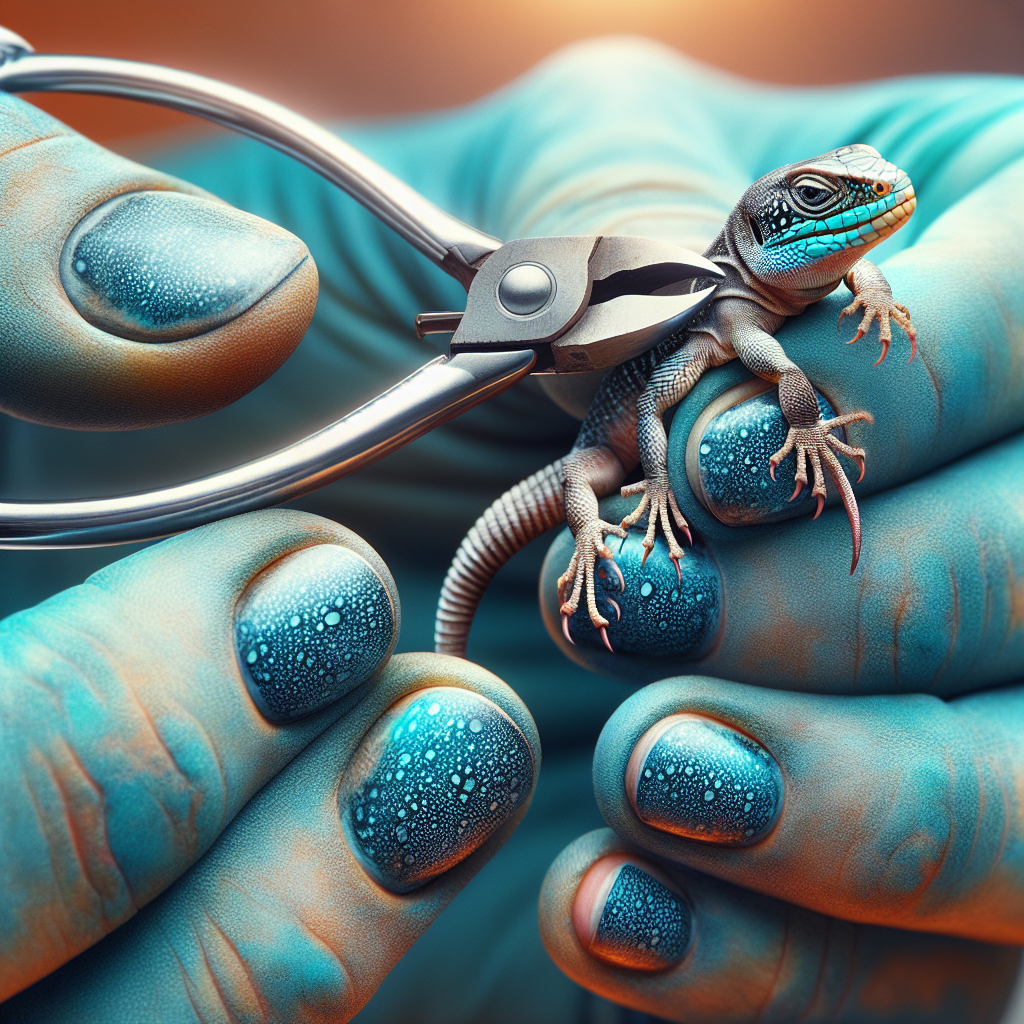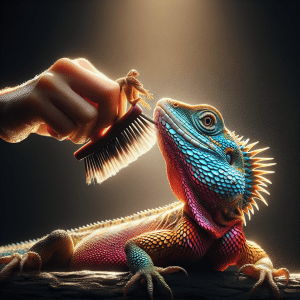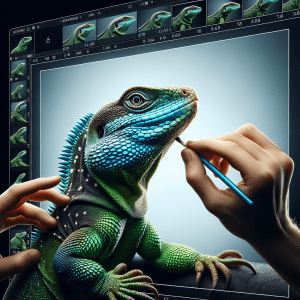Introduction: Importance of Trimming Lizard Nails Safely
Have you ever tried trimming your lizard’s nails? It might not be something you think about often, but it’s crucial for their well-being. Let me share some insights on the importance of safely trimming lizard nails.
Lizard nail trimming is not just about aesthetics; it plays a vital role in maintaining their health. Just like us humans, lizards need proper nail care to prevent potential issues. Imagine if you neglected your own nail care – it could lead to discomfort and even health problems. The same goes for our scaly friends!
Trimming lizard nails safely involves understanding their anatomy. Lizards’ nails are different from ours, so it’s essential to know the right techniques and tools to use. I once tried using regular nail clippers on my lizard, only to realize it was a disaster! Learning about their unique nail structure can save you from such mishaps.
Did you know that some lizards shed their nails as part of the molting process? It’s fascinating how nature has equipped these creatures with such adaptive mechanisms. Understanding these natural processes can guide us in caring for them more effectively. Plus, it’s just cool to learn about the intricacies of lizard biology!
When it comes to trimming their nails, patience is key. Lizards can be quite sensitive creatures, so it’s crucial to approach the process calmly and gently. Imagine if someone tried to forcefully trim your nails – not a pleasant thought, right? The same empathy should be extended to our reptilian companions.
As we delve into the world of lizard nail care, remember that it’s not just about the physical act of trimming. It’s about fostering a bond of trust and care with your pet. By prioritizing their well-being through safe nail trimming practices, you’re not just maintaining their hygiene, but also showing them love and respect. After all, a happy lizard means a happy owner!
Understanding Lizard Nail Anatomy
Did you know that lizards have a unique nail anatomy that differs from other animals? It’s not just a simple nail; it’s a specialized structure that serves multiple functions. When I first learned about the intricate details of a lizard’s nail anatomy, I was fascinated by how evolution has tailored these creatures for their specific habitats and lifestyles.
Lizards’ nails, also known as claws, vary in shape and size depending on the species. Some lizards have sharp, curved claws for climbing trees and catching prey, while others have blunt, sturdy claws for digging and burrowing. The diversity in nail shapes reflects the diverse ways in which lizards interact with their environments.
One interesting fact about lizard nails is that they are made of keratin, the same protein that makes up human hair and nails. However, lizard nails are much more specialized and have evolved to suit their needs perfectly. The structure of a lizard’s nail consists of layers that provide strength and flexibility, allowing them to grip surfaces effectively and perform various activities essential for survival.
Understanding the anatomy of a lizard’s nail is crucial when it comes to safely trimming them. Each part of the nail serves a specific purpose, and knowing how to handle them properly ensures that you maintain your lizard’s health and well-being. By familiarizing yourself with the unique features of lizard nails, you can approach the nail trimming process with confidence and care.
Next time you observe your lizard’s nails, take a moment to appreciate the intricate design and functionality of these fascinating structures. By understanding the complexity of lizard nail anatomy, you’ll be better equipped to provide proper nail care and maintenance for your scaly friend.
Tools Required for Safe Trimming
Have you ever tried trimming your lizard’s nails? It can be quite a task, but having the right tools makes a world of difference. I remember the first time I attempted to trim my lizard’s nails without the proper tools – let’s just say it didn’t go as smoothly as I had hoped!
One interesting fact about the tools required for safe trimming is that using specialized reptile nail clippers designed for small animals can make the process much easier and safer. These clippers are specifically designed to cut through the hard keratin of a lizard’s nails without causing any harm. Additionally, having a styptic powder on hand can be helpful in case of any accidental cuts to quickly stop bleeding.
Ensuring you have the right tools for the job is crucial when it comes to trimming your lizard’s nails safely. Investing in quality reptile nail clippers and having styptic powder as a backup can make the process less stressful for both you and your pet. By being prepared with the right tools, you can ensure a smooth and safe nail-trimming experience for your lizard.
So, next time you’re gearing up to trim your lizard’s nails, make sure you have the proper tools on hand. Your pet will thank you for it, and you’ll feel more confident in safely maintaining their nail health.
Step-by-Step Guide to Trimming Lizard Nails
Have you ever tried trimming your lizard’s nails? It can be a bit tricky at first, but once you get the hang of it, it’s not so bad! I remember the first time I attempted to trim my lizard’s nails – let’s just say it was quite the adventure.
When it comes to trimming lizard nails, it’s essential to follow a step-by-step guide to ensure you’re doing it safely and effectively. You don’t want to accidentally hurt your little buddy, right? So, grab your tools – nail clippers specifically designed for reptiles are a must-have. These will make the process much easier and less stressful for both you and your lizard.
Start by gently restraining your lizard to prevent any sudden movements that could lead to accidental cuts. Remember, patience is key here. Slowly and carefully trim a small portion of the nail at a time, making sure to avoid the quick – the sensitive part of the nail that contains blood vessels and nerves.
As you proceed through the trimming process, pay close attention to your lizard’s body language. Are they getting antsy or showing signs of discomfort? If so, it’s best to take a break and try again later. It’s essential to prioritize your pet’s well-being during this grooming session.
Once you’ve successfully trimmed all the nails, reward your lizard with a treat or some extra cuddles. Positive reinforcement goes a long way in making nail trimming a more pleasant experience for both of you. And remember, regular nail maintenance is crucial for your lizard’s overall health and comfort.
So, how do you feel about giving nail trimming a try with your lizard? It may seem daunting at first, but with the right approach and a little practice, you’ll become a pro in no time. Just remember, patience, and a gentle touch are key to keeping your lizard’s nails in top shape!
Precautions to Take During Nail Trimming
Have you ever noticed your lizard’s nails getting a bit too long? It can be a real hassle to deal with, right? Well, let me tell you about the signs of overgrown nails in lizards. It’s fascinating how our little reptile friends can communicate their nail care needs without saying a word!
When I first noticed my bearded dragon’s nails were looking a bit unruly, I wasn’t quite sure what to do. That’s when I started paying closer attention to his behavior. I noticed him struggling to grip onto his favorite basking spot, and sometimes he seemed a bit uncomfortable moving around. It was a lightbulb moment for me – those overgrown nails were causing him some discomfort!
Did you know that overgrown nails in lizards can lead to various health issues? It’s not just about aesthetics; it can actually impact their overall well-being. Imagine walking around in shoes that are too tight – not a pleasant experience, right? Well, lizards can feel the same discomfort when their nails are too long.
Recognizing the signs of overgrown nails is crucial for ensuring your lizard stays happy and healthy. By observing their behavior and checking their nails regularly, you can stay ahead of any potential issues. Remember, prevention is always better than cure when it comes to your pet’s well-being.
So, take a moment to observe your lizard’s nails today. Are they looking a bit long? Keep an eye out for any signs of discomfort or difficulty moving around. By staying proactive and addressing overgrown nails promptly, you can help your lizard stay comfortable and content. Trust me, your scaly friend will thank you for it!
Signs of Overgrown Nails in Lizards
You know, it’s fascinating how something as small as overgrown nails can impact our little lizard friends. Have you ever noticed the signs of overgrown nails in your own pet lizard? It’s quite a common issue among lizard owners, and being aware of these signs can really help us take better care of our scaly pals.
I remember when I first noticed that my lizard’s nails were getting a bit too long. It was during one of our play sessions, and I noticed that he was having trouble gripping onto surfaces like he used to. That’s when I realized it might be time for a nail trim.
Overgrown nails in lizards can lead to various problems, such as difficulty moving around, discomfort, and even potential injuries. It’s crucial to pay attention to these signs and address them promptly to ensure our lizards stay healthy and happy.
Did you know that some lizards may naturally wear down their nails through regular activity, but others may require occasional trims to maintain optimal nail health? It’s important to understand your specific lizard’s needs and provide the necessary care accordingly.
Regular nail maintenance not only keeps your lizard comfortable but also prevents potential health issues down the line. Plus, it can be a great bonding experience between you and your scaly companion. So, have you considered the benefits of incorporating nail trimming into your lizard care routine?
What do you think about the idea of giving your lizard a little spa day with a nail trim session? It can be a fun way to show your pet some love while ensuring their well-being. Let’s dive deeper into the world of lizard nail care and explore how we can keep our reptilian friends looking sharp and feeling their best.
Benefits of Regular Nail Maintenance for Lizards
Have you ever noticed how a lizard’s nails can sometimes grow surprisingly fast? It’s like they have a secret superpower for nail growth! But in all seriousness, maintaining your lizard’s nails is crucial for their overall health and well-being.
Regular nail maintenance for lizards, as I’ve learned, goes beyond just keeping their claws trim and tidy. It actually plays a significant role in their overall comfort and mobility. Imagine if you had to walk around with overgrown nails – uncomfortable, right? The same goes for our scaly friends.
One interesting fact I recently came across is that overgrown nails in lizards can lead to various health issues, such as difficulty walking or climbing. By ensuring their nails are properly trimmed, we can prevent these problems and keep our little buddies happy and healthy.
So, why is it so important to prioritize regular nail maintenance for your lizard? Well, think about how essential it is for them to be able to move around freely and comfortably. Just like we enjoy a good mani-pedi for self-care, our lizards deserve the same level of attention when it comes to their nail health.
Taking the time to learn how to safely trim your lizard’s nails can make a world of difference in their quality of life. Not only will they be able to move around more easily, but you’ll also reduce the risk of them getting their nails caught on objects or accidentally scratching themselves.
By incorporating a routine nail-trimming schedule into your lizard care regimen, you’re not only promoting their physical well-being but also strengthening the bond between you and your scaly companion. After all, a happy lizard with well-maintained nails is a healthier lizard overall.
Common Mistakes to Avoid When Trimming
Have you ever trimmed your pet lizard’s nails and ended up feeling like you needed a nail trim yourself? It can be a tricky task, but fear not, I’ve got some tips to help you avoid those nail-trimming mishaps.
Let’s dive into some common mistakes that many lizard owners make when trimming their pet’s nails. One of the biggest blunders is using the wrong type of nail trimmers. It’s essential to use specialized reptile nail clippers or small, sharp scissors designed for the task. Using human nail clippers or dull scissors can crush or splinter the nail, causing discomfort to your lizard.
Another mistake to steer clear of is cutting the nails too short. Just like us, lizards have a quick (the pink part inside the nail that contains blood vessels and nerves), and cutting into it can be painful and lead to bleeding. Always aim to trim only the sharp tip of the nail to prevent accidental injury.
Additionally, not keeping the lizard calm during the nail-trimming process can result in a stressful experience for both of you. Lizards can be sensitive creatures, so creating a calm environment and handling them gently is key to a successful nail-trimming session. You might want to consider having a friend or family member assist you in holding the lizard securely while you focus on the trimming.
Lastly, rushing through the process is a common mistake that can lead to accidents. Take your time and proceed cautiously, especially if it’s your first time trimming your lizard’s nails. It’s better to trim a little at a time and monitor your lizard’s reaction rather than attempting to do it all in one go.
By avoiding these common pitfalls, you can make the nail-trimming experience a stress-free and safe one for you and your beloved pet lizard. Remember, patience and precision are key when it comes to keeping those lizard nails in tip-top shape.
Tips for Calming Your Lizard During Nail Trimming
Have you ever tried calming down a lizard before trimming its nails? It can be quite a challenge, but with the right approach, it’s totally doable!
One practical tip I’ve found helpful is to create a calming environment for your lizard before starting the nail trimming process. Imagine this – soft music playing in the background, a cozy spot with some warm light, and maybe even a little lizard massage (yes, that’s a thing!). By setting the mood just right, you can help your lizard relax and make the nail trimming experience much smoother for both of you.
The key is to approach it with patience and gentleness. Lizards are sensitive creatures, so it’s important to handle them with care. Try talking to your lizard in a soothing voice and moving slowly and steadily while trimming its nails. Remember, the goal is to keep your lizard comfortable and stress-free throughout the process.
Another handy tip is to use treats as a positive reinforcement. Offering your lizard a tasty treat before and after the nail trimming can help create a positive association with the experience. Just make sure the treats are safe for your lizard to eat!
So, the next time you find yourself gearing up to trim your lizard’s nails, remember to set the mood, be patient, and reward your scaly friend for their cooperation. With a little bit of TLC and these tips in mind, you’ll be a pro at calming your lizard during nail trimming in no time!
Conclusion: Ensuring the Well-being of Your Pet Lizard
Have you ever tried trimming your lizard’s nails? It can be quite the adventure! When I first attempted it with my bearded dragon, I was a nervous wreck. The little guy squirmed and wriggled, making it feel like a wrestling match more than a grooming session. But over time, I’ve learned some valuable tips and tricks to make the process smoother for both of us.
Understanding the importance of safely trimming lizard nails is crucial to maintaining your pet’s overall health and well-being. Lizards, like most animals, require regular nail maintenance to prevent overgrowth, which can lead to discomfort and potential health issues. By following a step-by-step guide and taking necessary precautions, you can ensure a stress-free nail trimming experience for your scaly friend.
One practical tip that has worked wonders for me is creating a calm and comfortable environment before starting the trimming process. Lizards are sensitive creatures, and any sudden movements or loud noises can make them anxious. By dimming the lights, playing soothing music, and offering treats as positive reinforcement, you can help your lizard relax during the nail trimming session.
It’s fascinating to learn about the anatomy of lizard nails and how they differ from other animals. Did you know that lizards have specialized keratin structures in their nails that serve various functions, including aiding in climbing, digging, and defense? Understanding these unique features can help you approach nail trimming with care and precision.
So, the next time you find yourself gearing up for a lizard nail trimming session, remember to arm yourself with the right tools, knowledge, and patience. Your pet will thank you for keeping their nails in tip-top shape, and you’ll both enjoy a smoother and more enjoyable grooming experience.




